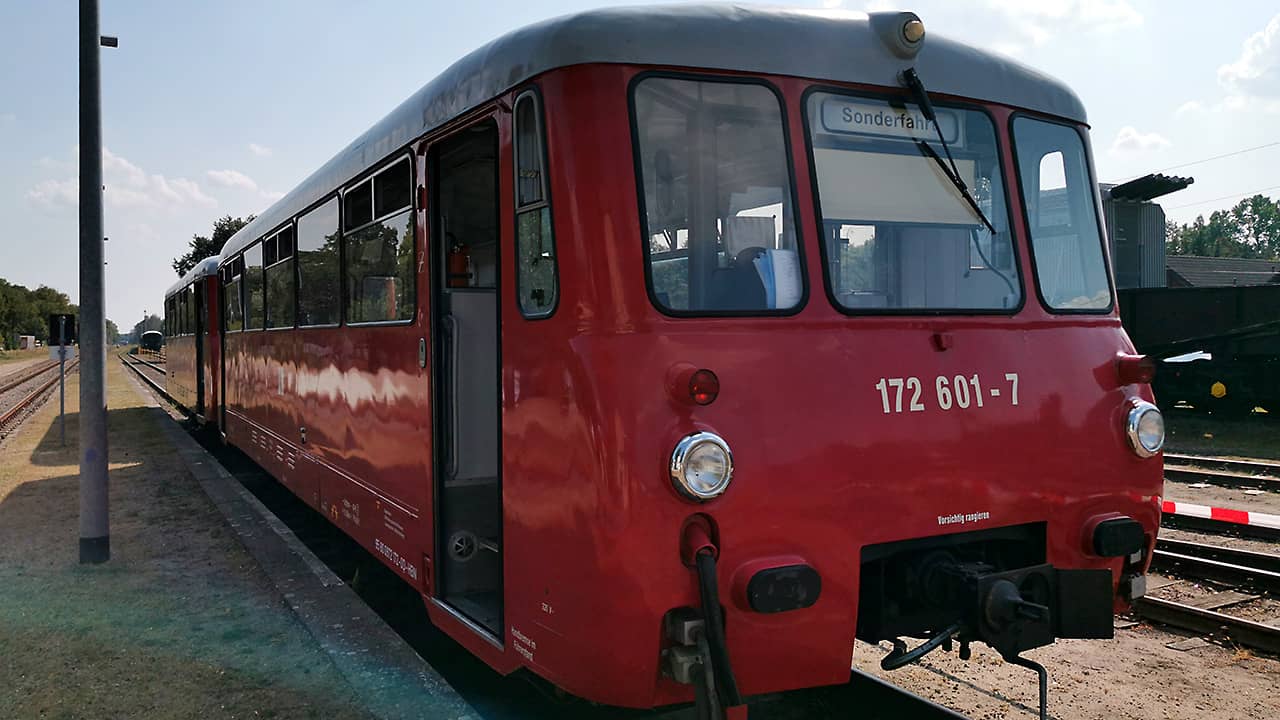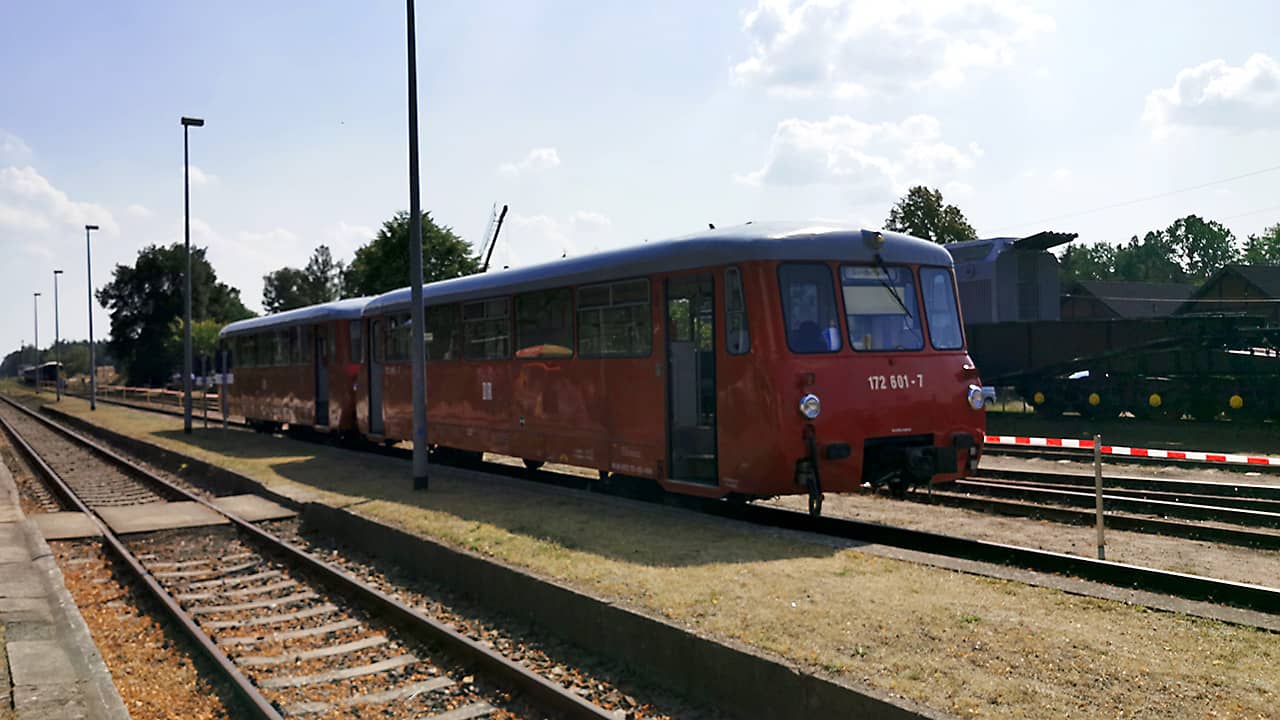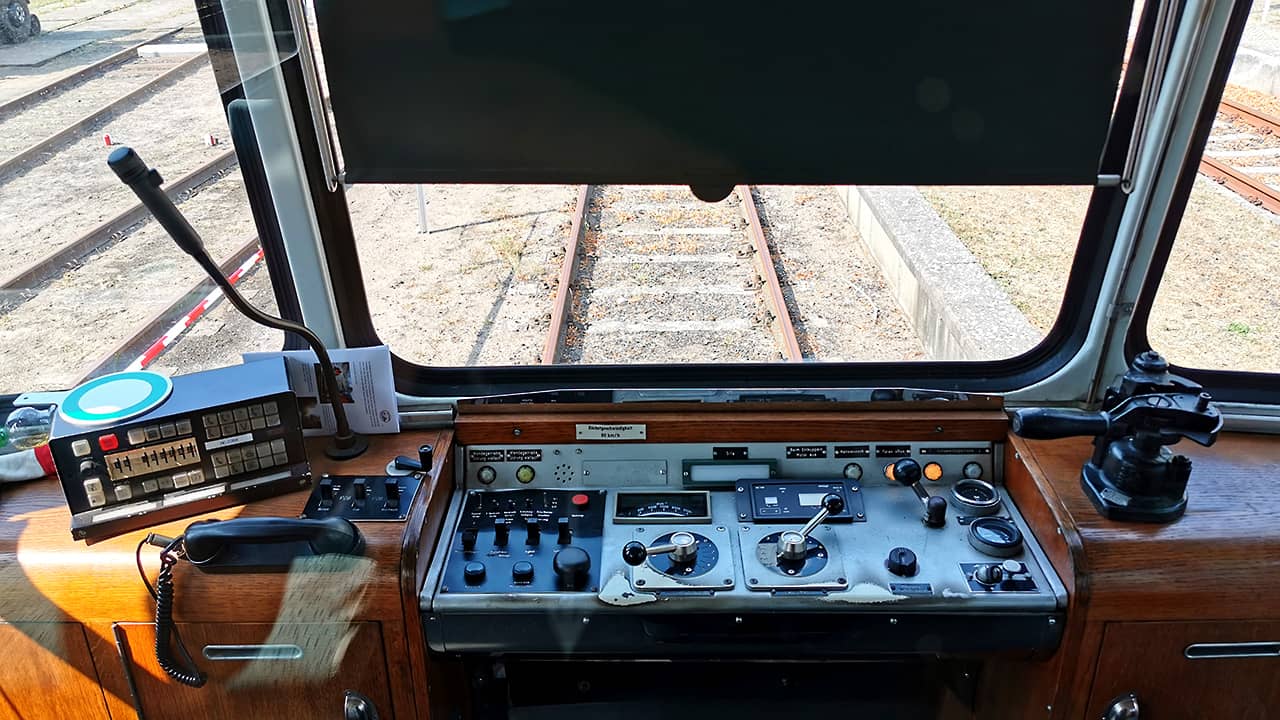DR Class VT 2.09 - Railcar of the Deutsche Reichbahn
DR class 171/172 (VT 172 or formerly DR Class VT 2.09) were rail buses of the Deutsche Reichsbahn, which were developed and built by VEB Waggonbau Bautzen. At the Deutsche Bahn AG they were called class 771/772.
| Manufacturer: | VEB Waggonbau Bautzen, VEB Waggonbau Görlitz |
| Length: | 13,550 mm |
| Numbering: | VT 2.09.001 (type), VT 2.09.002 (type 2), VT 2.09.003-007 (zero series vehicles), VT 2.09.008-070, VT 2.09.101-116, VT 2.09.201-273 |
| Weight: | 15.6 - 19.3 t |
| Years of construction: | 1957 (type), 1962-1969 (series) |
| Top speed: | 90 km/h |
| Retirement: | by 2004 (OBS by 2019) |
| Power: | 180 hp = 132 kW 220 hp = 162 kW |
| Engine type: | Büssing AG U 10 |
| Propulsion: | Diesel-mechanical/ Hydromechanical |
| Brake: | K-P+Mg and additional brake (railcar) K-P and additional brake (driving trailer) K-P (sidecar) |
| axle formula: | 1A |
| Seats: | 54 |
| Interesting facts |
|---|
| The DR Class VT 2.09 railcars belong to the type with axle sequence 1A. Axle arrangement 1A is a driven axle fixed in the main frame. More interesting facts |
The history of the DR Class VT 2.09 railcar
The DR Class VT 2.09 rail buses, which were officially designated as light combustion railcars, were developed from 1955 by VEB Waggonbau Bautzen. The first two vehicles were not presented until 1959 and were used as planned from 1962. The first two vehicles had a Büssing engine. Six more railcars with sidecars were produced in the same year. The first series production started in 1963 (VT 2.09.008 – 070).
In 1965, sixteen railcars and, for the first time, control cars were built. This meant that it was no longer necessary to move them at the end of the line. Further series were manufactured in the wagon construction Görlitz, from 1969 73 railcars and 72 control cars.
The use of the DR Class VT 2.09 was limited to branch lines. Due to the use of non-radially adjustable axles and an axle base of 6000 mm, a special permit was required. The vehicles were first put into service under the designation DR Class VT 2.09 / VT 2.08 / VT 2.07, before they were redesignated in 1970 as motor vehicles in the class 171.0 and 171.8 (sidecar).
The original version of the Series 172 consists of a motor vehicle with 2 driver’s cabs and a driving trailer with a driver’s cab. There are two double folding doors on each side. The railcars also had an optical-acoustic door-closing warning system consisting of a bell and a red warning light, which was activated before the doors were closed. There was only one special feature in the 172 series, namely the multiple and reversing train control also for double traction. This meant that up to six cars could be driven together. The series also had Scharfenberg couplers.
The VT 172 was powered by a 6VD 18/15 six-cylinder in-line engine from VEB Elbewerk Roßlau, which was arranged in an underfloor design. Power was transmitted to a six-speed electric gearbox via a permanently filled fluid coupling. All gears of this transmission are engaged. They are flanged to the secondary shaft by electrically operated friction disc clutches with integrated freewheels (overrunning clutch). This prevents engine and transmission damage due to incorrect gear selection.
The motor vehicle was powered by a 12V / 1.2 kW alternator and by an axle generator in the sidecar and control car. This was driven by a leather flat belt. In the course of the modernization, the axle generators with their interference-sensitive drive were replaced by a central power supply, which was fed by the railcar. Due to the low power generated by the axle generators at the numerous slow speed points, the railcars were finally converted to two alternators connected in parallel. The engine was cooled by an underfloor cooler suspended under the first driver’s cab. The radiator was driven by a hydrostatic engine using V-belts.
The passenger compartment of the VTs was heated by a cooling water-fed and an oil-fired air heater, the control cars and sidecars each had two oil-fired air heaters. These were controlled by thermostats.
The DR Class VT 2.09 series was equipped with disc brakes on all axles, each with an internally ventilated brake disc. In addition, the railcars were equipped with a low-suspended magnetic disc brake, which became effective in the rapid braking position of the driver’s brake valve. In this way, short braking distances could be achieved in an emergency on dirty or greasy roads.
Modernization of the DR Class VT 2.09 railcars
On 1 January 1992, the railcars were given the series numbers 771 and 772 when they were transferred to the Deutsche Bundesbahn series scheme. Many vehicles were equipped with MESA train radios and PZ 80 at the beginning of the 1990s. Light-coloured Sprelacart panels and laminated glass windows were used in the interior.
The upholstery was changed from purple red to green. Furthermore, a partition wall with lockable door and window between passenger compartment and driver’s cab was installed. The wooden consoles were replaced by GFK consoles. This reduced the number of seats from 54 to 40. The motor was replaced by the type MAN 2866 UH with 162 kW, partly the electric gearboxes were replaced by flow gearboxes of the type Voith Diwa D 863.
The necessary EBuLa (electronic timetable) was also retrofitted. Some control cars were converted to motor coaches by installing an engine. Two traction units used on Usedom were converted to natural gas propulsion.
changed.
Whereabouts of the DR Class VT 2.09 railcars
The last regular location of the railcars was Stendal. 772 155 was parked here on 14 January 2004. In Heringsdorf and Zinnowitz on Usedom some railcars and sidecars are still parked. Some were externally reconditioned, including the natural gas-powered 772 201 with sidecar 972 201.
From 26 January 2006 to 30 March 2019, the two railcars 772 140 and 141, modernised with a closed WC system and in the original DR paintwork, were used again by the RegioNetz Oberweißbacher Berg- und Schwarzatalbahn. They were mainly used for special trips, but were also used in regular operation. In the meantime, however, they have been sold.
22 railcars were sold to Cuba and Romania. Other vehicles went to Spain to Gestor de Infraestructuras Ferroviarias, a track construction company, and to Julius Berger Nigeria (JBN), a subsidiary of Bilfinger, and to Brazil. Some railcars are used by various railway associations in eastern Germany for special trips. These associations include “Hafenbahn Neustrelitz e.V.” and “Ostsächsische Eisenbahnfreunde e.V.”. The associations “Traditionsgemeinschaft Ferkeltaxi e.V.” and “Eisenbahnnostalgie Vorgtland” also use their railcars regularly.
Since 9 December 2012, the railcar 172 001 of Hafenbahn Neustrelitz e.V. and the railcar 172 171 of Köstner Schienenbusreisen from Chemnitz have been in regular service on the Mirow – Neustrelitz line.
The 772 342 railcar, painted in traffic red, was on display at Leipzig Central Station for several years. It was sold to the association “Lausitzer Dampflok Club e.V.” and received a new general inspection in April 2010. 772 332 was also repainted in traffic red and is available for special trips.
The following railcars are operational:
772 001 + 972 601: Neustrelitz Harbour Railway
772 342, 772 332: Lusatian Steam Locomotive Club
772 140, 772 141: PRESS
772 171, 772 132, 972 760: Traditional community of piglet taxis
771 056, 772 155, 772 312, 772 367, 972 741: Railway nostalgia Vogtland
772 413 + 972 502: East Saxon railway friends Löbau
772 173: Usedomer Railway GbR
772 345: Erfurt rail service
The VT 172 or the class 771/772 got many nicknames in the course of time. The best known is “Ferkeltaxe”, but also blood bubble, sandman’s train or owl are nicknames for this railcar.



